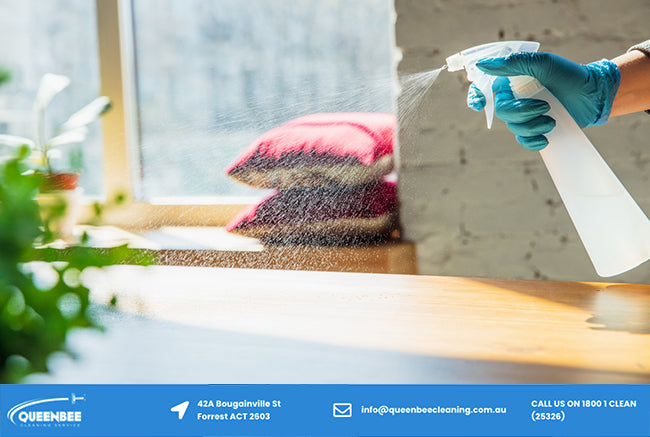Detailed Everyday Cleaning Tips: From Defrosted and Cleaned Every Few Months to Removing Clutter
Detailed Everyday Cleaning Tips: From Defrosted and Cleaned Every Few Months to Removing Clutter
Blog Article
Understanding the Requirement for Extensively Decontaminating and Disinfecting Regularly Touched Surfaces in High-Traffic Locations
In the world of public health and security, the meticulous disinfection and sanitization of often touched surface areas in high-traffic locations stand as vital procedures in stopping the spread of dangerous virus. By discovering the various facets of surface sanitation, from the risks associated with overlooking cleaning protocols to the efficient approaches that can be employed, a more clear understanding emerges of the crucial role these methods play in guarding public health and wellness.
Relevance of Surface Area Sanitation
Emphasizing the comprehensive sanitation of high-traffic surface areas is vital in preserving a sanitary atmosphere and stopping the spread of hazardous microorganisms. High-touch surface areas such as door takes care of, light switches, lift switches, and countertops work as reproducing premises for infections and bacteria. Routine sanitation of these surfaces is imperative to lower the danger of contamination and transmission of ailments.
By executing a durable disinfection protocol, services and establishments can create a safer environment for staff members, customers, and visitors. Appropriate surface area sanitation not just mitigates the spread of contagious diseases yet additionally imparts self-confidence in the tidiness and security of the properties. This positive technique shows a commitment to wellness and wellness, which is especially crucial in high-traffic areas where the probability of direct exposure to pathogens is heightened.
In addition, surface area disinfection plays an essential role in total infection control approaches. Integrated with hand hygiene practices, wearing masks, and maintaining physical distancing, extensive sanitation of high-touch surface areas forms a detailed defense versus the transmission of harmful microbes. Prioritizing surface sanitation is a necessary part of a holistic method to health and wellness and safety in shared rooms.
Threats of Neglecting Cleaning Practices
Neglecting extensive disinfection of high-traffic surface areas significantly enhances the risk of viral and bacterial contamination, posturing a major threat to the health and wellness of individuals frequenting these spaces. Failure to implement correct cleaning methods can bring about the accumulation and spread of unsafe microorganisms, including bacteria and viruses, on often touched surface areas such as doorknobs, hand rails, elevator buttons, and counter tops.

Additionally, ignoring the importance of complete cleaning not only jeopardizes the well-being of individuals but also weakens efforts to keep a hygienic and clean setting. It is critical to acknowledge the significance of proper sanitation procedures in preventing the spread of infections and securing public health.
Efficient Disinfection Methods
To keep optimum tidiness and minimize the risk of contamination on high-traffic surface areas, utilizing effective sanitation techniques is essential. Among one of the most common and efficient sanitation approaches is using chemical anti-bacterials. These products can differ in strength and make-up, with some targeting details pathogens like germs or infections. It is critical to follow the producer's instructions for proper dilution, contact time, and ventilation when using chemical anti-bacterials to ensure their efficiency - Vacuum Carpets.
One more effective approach is using UV-C light. UV-C light has actually been shown to be efficient in killing a vast array of microbes by disrupting their DNA structure, thus stopping them from duplicating. Nevertheless, it is necessary to make use of UV-C light appropriately, making sure that the right strength and direct exposure time are used to achieve the desired sanitation outcomes.
Furthermore, utilizing steam cleaning as a disinfection technique can be extremely effective, specifically on surfaces that are heat-resistant. Heavy steam can pass through permeable surfaces and kill germs, viruses, advice and other virus properly. When using vapor cleaning, it is necessary to guarantee that the surface reaches the called for temperature for an adequate amount of time to guarantee proper sanitation.
Influence On Public Wellness
The maintenance of high standards of cleanliness and disinfection on high-traffic surfaces plays a critical function in guarding public health. Regularly touched surfaces in areas with high tramp, such as doorknobs, handrails, elevator buttons, and restroom centers, offer as reproducing premises for hazardous pathogens.
In high-traffic areas like flight terminals, institutions, medical facilities, and public transportation systems, the impact of strenuous sanitation steps can not be downplayed. Prioritizing the sanitization of often touched surfaces is a positive method to advertising public health and wellness and enhancing the security of people in shared areas.
Applying Regular Cleansing Methods
Immediately instituting and adhering to a consistent routine of cleaning protocols is critical for maintaining the sanitation and security of high-traffic surface areas. Regular cleaning procedures are crucial in stopping the build-up of germs and pathogens on often touched surface areas, particularly in locations with high foot traffic. By executing a systematic technique to cleaning, organizations can effectively decrease the threat of illness transmission and produce a healthier atmosphere for staff members, consumers, and the public.
To establish a reliable cleansing routine, it is vital to identify high-traffic locations that call for constant attention. These areas might include doorknobs, hand rails, elevator switches, toilet facilities, and common tools. Implementing a routine cleansing regimen that targets these surfaces several times a day can considerably lower the spread of damaging microorganisms and viruses.
Moreover, making use of suitable cleaner and anti-bacterials is crucial to making certain that surfaces are extensively sanitized. Regular training of cleaning staff on proper cleaning strategies and the significance of adherence to the cleaning routine is additionally vital in maintaining a sanitary setting. By focusing on constant cleansing procedures, organizations can advertise the health and wellness of individuals that interact with these high-traffic surfaces.

Final Thought
In final thought, it is crucial to focus on comprehensive sanitation and sanitization of regularly touched surface areas in high-traffic locations to stop the spread of harmful pathogens and preserve public health. Ignoring proper cleansing methods can boost the risk of contamination and transmission of diseases. By implementing regular cleaning protocols and utilizing effective disinfection methods, article we can produce a much safer atmosphere for everyone (Everyday cleaning). It is important to identify the significance of pop over to this web-site keeping tidy surfaces in high-traffic areas to guarantee the well-being of the neighborhood.
In the world of public health and wellness and safety, the careful disinfection and sanitization of frequently touched surface areas in high-traffic areas stand as critical procedures in stopping the spread of damaging microorganisms. By exploring the different elements of surface area sanitation, from the threats connected with disregarding cleaning protocols to the reliable approaches that can be employed, a more clear understanding arises of the crucial duty these techniques play in safeguarding public health.Furthermore, employing steam cleaning as a sanitation method can be highly effective, specifically on surfaces that are heat-resistant. When making use of vapor cleaning, it is crucial to make certain that the surface area reaches the called for temperature for an enough amount of time to assure appropriate sanitation.
In final thought, it is vital to focus on detailed sanitation and sanitization of often touched surface areas in high-traffic locations to stop the spread of unsafe virus and maintain public wellness.
Report this page